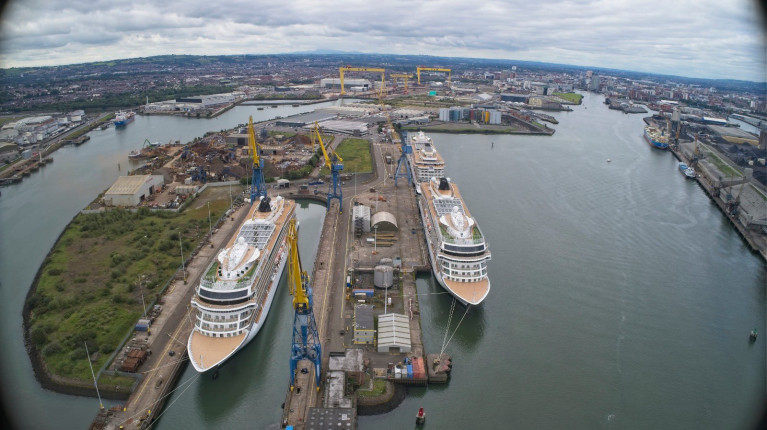Displaying items by tag: Viking Cruises
Plans to Raise £9m By Owners of Harland & Wolff (Where Cruiseship Trio Occupy Belfast Shipyard)
Owner of Belfast's iconic Harland and Wolff shipyard, InfraStrata, is set to move forward with its plans to raise £9m.
The company, reports InsiderMedia, first outlined its proposals in early July, with the motion having now been passed by shareholders.
An application has been made for 1,791,428,683 ordinary shares to be admitted to trading on AIM. Following this, InfraStrata's issued share capital will comprise 6,416,008,200 ordinary shares.
Earlier this year, Harland and Wolff secured a £2m asset-backed term debt facility.
The east Belfast facility is where work on ferry and cruise firms have used Covid-19 shutdown to carry out maintenance as The Belfast Telegraph reported last month.
The cruise industry is in the worst crisis in its history as a result of coronavirus, and passenger ferries have also taken a hit in lockdown.
But for Harland & Wolff, itself facing a fight for survival a year ago, the stricken industries are a major source of work as cruise ships and ferries take up residence in its dry docks for maintenance.
Instead of sailing around the world, three ships from Viking Cruises - affectionately called the "three sisters" - are being refitted by H&W staff.
On the same day of the newspaper's report Afloat.ie tracked the cruiseship trio where the Viking Sun was dry-docking within Belfast Dry Dock, the smaller of two such facilities which H&W claim to be the largest dry docks in Europe.
While adjacent to BDD at the fit-out quay were berthed Viking Sea and Viking Sky, the latter ship with nearly 400 people were airlifted during an incident when adrift off Norway last year.
Each of the 930 passenger cruiseships, currently remain at the shipyard, have a gross tonnage of 47,842 and were all built in 2017 except for Viking Sea which entered service the previous year. They were all built in Ancona, Italy following leadship of the series Viking Star which was launched in Marghera also in Italy.
Afloat also tracked the Belfast 'berthed' pair as far back to 1 July at the fit-out berth. Viking Sea having arrived at the Belfast shipyard on 23 June from Alesund, Norway while Viking Sky also carried out the same voyage across the North Sea and arrived the same day.
As for the third cruiseship, Viking Sun was that day in the Irish Sea but having departed Belfast bound for Douglas, Isle of Man. The cruiseship departed the Ulster capital on Wednesday and was expected to arrive offshore of the Manx capital the next day.
During the height of Covid-19, Viking Cruises announced on 11 March that they became the first cruise line to temporarily suspend operations of their ocean and river cruises. This was to ensure a commitment to guests and employees is that safety and wellbeing is always a top priority.
In that spirit, Viking Cruises made the decision to extend the temporary suspension of operations across all sailings through to 30th September.





























































